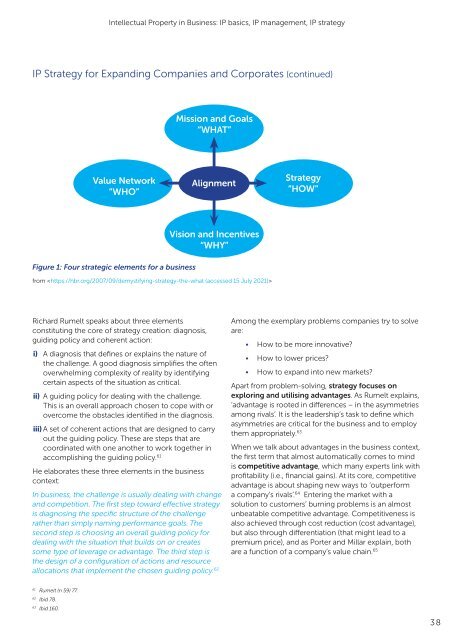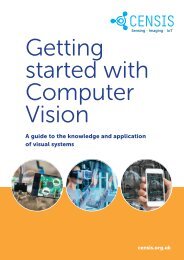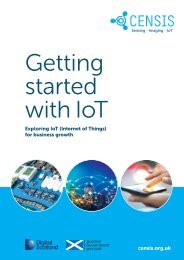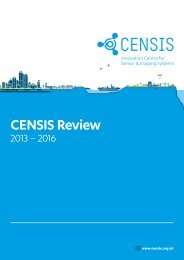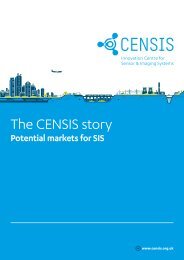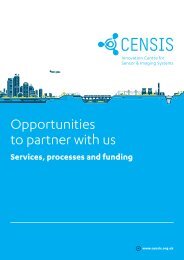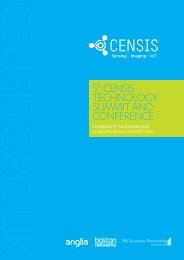CENSIS white paper: Intellectual Property in Business
2023: This CENSIS white paper sets out to make the topic of IP more approachable, less intimidating and more manageable, offering experience-based advice and methods are are designed to help businesses structure their IP- related issues and makes the best of their IP. Covering: The role of IP, IP management during growth, IP strategy for expanding companies and corporates, Business IP Canvas - merging IP with your business model.
2023: This CENSIS white paper sets out to make the topic of IP more approachable, less intimidating and more manageable, offering experience-based advice and methods are are designed to help businesses structure their IP- related issues and makes the best of their IP.
Covering:
The role of IP, IP management during growth, IP strategy for expanding companies and corporates, Business IP Canvas - merging IP with your business model.
You also want an ePaper? Increase the reach of your titles
YUMPU automatically turns print PDFs into web optimized ePapers that Google loves.
<strong>Intellectual</strong> <strong>Property</strong> <strong>in</strong> Bus<strong>in</strong>ess: IP basics, IP management, IP strategy<br />
IP Strategy for Expand<strong>in</strong>g Companies and Corporates (cont<strong>in</strong>ued)<br />
Mission and Goals<br />
“WHAT”<br />
Value Network<br />
“WHO”<br />
Alignment<br />
Strategy<br />
“HOW”<br />
Vision and Incentives<br />
“WHY”<br />
Figure 1: Four strategic elements for a bus<strong>in</strong>ess<br />
from <br />
Richard Rumelt speaks about three elements<br />
constitut<strong>in</strong>g the core of strategy creation: diagnosis,<br />
guid<strong>in</strong>g policy and coherent action:<br />
i) A diagnosis that def<strong>in</strong>es or expla<strong>in</strong>s the nature of<br />
the challenge. A good diagnosis simplifies the often<br />
overwhelm<strong>in</strong>g complexity of reality by identify<strong>in</strong>g<br />
certa<strong>in</strong> aspects of the situation as critical.<br />
ii) A guid<strong>in</strong>g policy for deal<strong>in</strong>g with the challenge.<br />
This is an overall approach chosen to cope with or<br />
overcome the obstacles identified <strong>in</strong> the diagnosis.<br />
iii) A set of coherent actions that are designed to carry<br />
out the guid<strong>in</strong>g policy. These are steps that are<br />
coord<strong>in</strong>ated with one another to work together <strong>in</strong><br />
accomplish<strong>in</strong>g the guid<strong>in</strong>g policy. 61<br />
He elaborates these three elements <strong>in</strong> the bus<strong>in</strong>ess<br />
context:<br />
In bus<strong>in</strong>ess, the challenge is usually deal<strong>in</strong>g with change<br />
and competition. The first step toward effective strategy<br />
is diagnos<strong>in</strong>g the specific structure of the challenge<br />
rather than simply nam<strong>in</strong>g performance goals. The<br />
second step is choos<strong>in</strong>g an overall guid<strong>in</strong>g policy for<br />
deal<strong>in</strong>g with the situation that builds on or creates<br />
some type of leverage or advantage. The third step is<br />
the design of a configuration of actions and resource<br />
allocations that implement the chosen guid<strong>in</strong>g policy. 62<br />
Among the exemplary problems companies try to solve<br />
are:<br />
• How to be more <strong>in</strong>novative?<br />
• How to lower prices?<br />
• How to expand <strong>in</strong>to new markets?<br />
Apart from problem-solv<strong>in</strong>g, strategy focuses on<br />
explor<strong>in</strong>g and utilis<strong>in</strong>g advantages. As Rumelt expla<strong>in</strong>s,<br />
‘advantage is rooted <strong>in</strong> differences – <strong>in</strong> the asymmetries<br />
among rivals’. It is the leadership’s task to def<strong>in</strong>e which<br />
asymmetries are critical for the bus<strong>in</strong>ess and to employ<br />
them appropriately. 63<br />
When we talk about advantages <strong>in</strong> the bus<strong>in</strong>ess context,<br />
the first term that almost automatically comes to m<strong>in</strong>d<br />
is competitive advantage, which many experts l<strong>in</strong>k with<br />
profitability (i.e., f<strong>in</strong>ancial ga<strong>in</strong>s). At its core, competitive<br />
advantage is about shap<strong>in</strong>g new ways to ‘outperform<br />
a company’s rivals’. 64 Enter<strong>in</strong>g the market with a<br />
solution to customers’ burn<strong>in</strong>g problems is an almost<br />
unbeatable competitive advantage. Competitiveness is<br />
also achieved through cost reduction (cost advantage),<br />
but also through differentiation (that might lead to a<br />
premium price), and as Porter and Millar expla<strong>in</strong>, both<br />
are a function of a company’s value cha<strong>in</strong>. 65<br />
61<br />
Rumelt (n 59) 77.<br />
62<br />
Ibid 78.<br />
63<br />
Ibid 160.<br />
38


